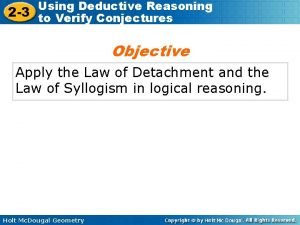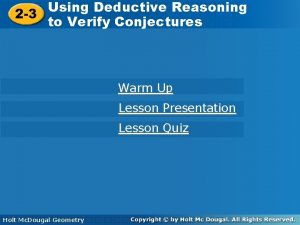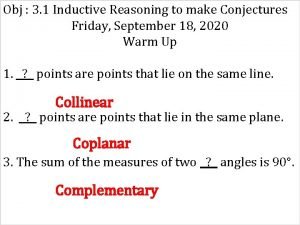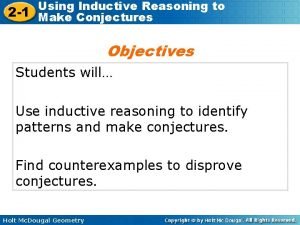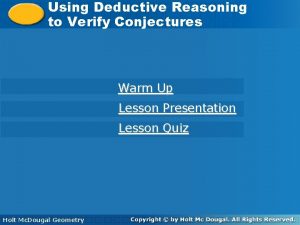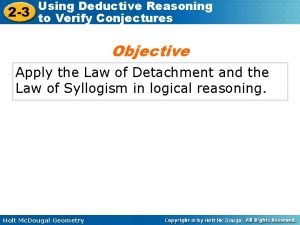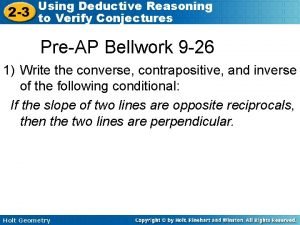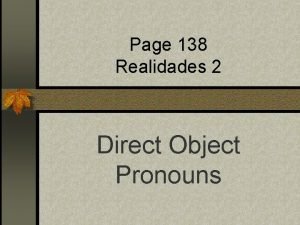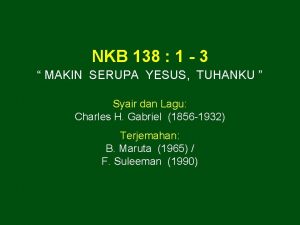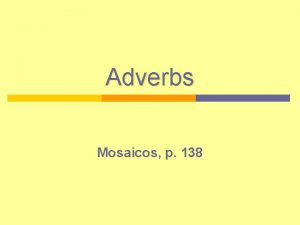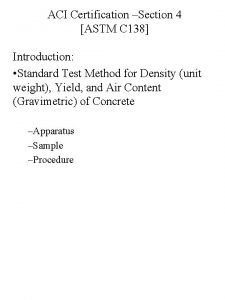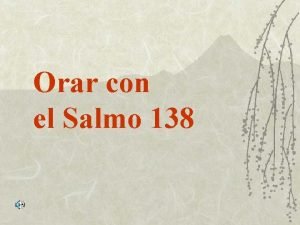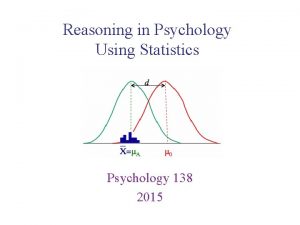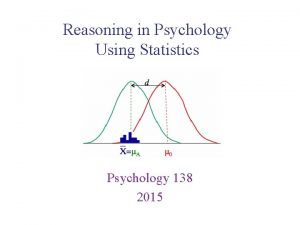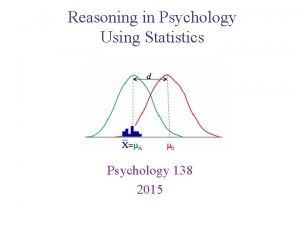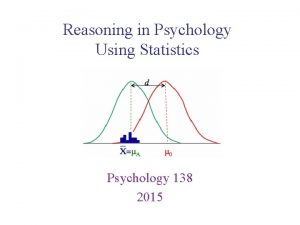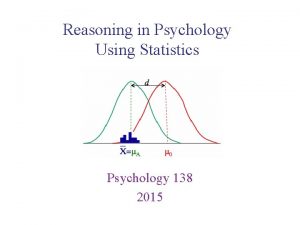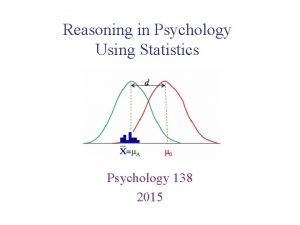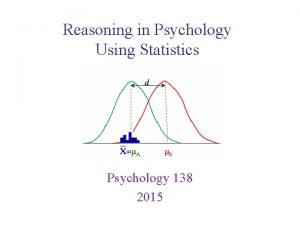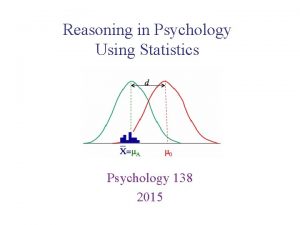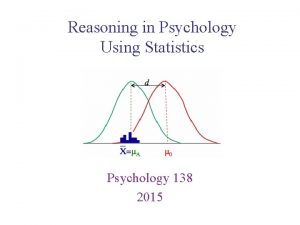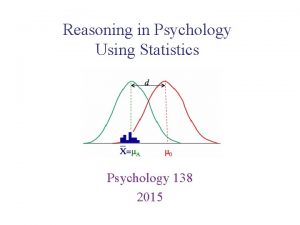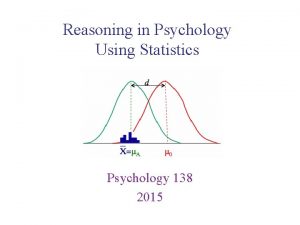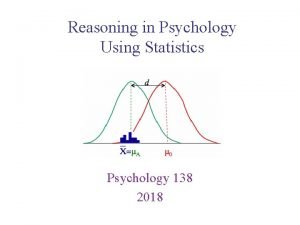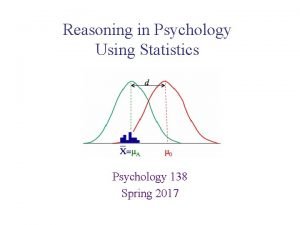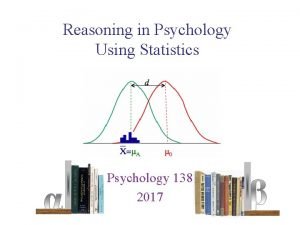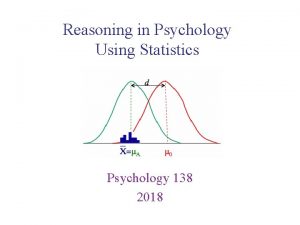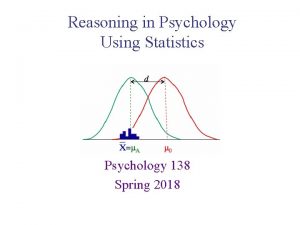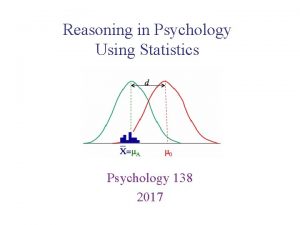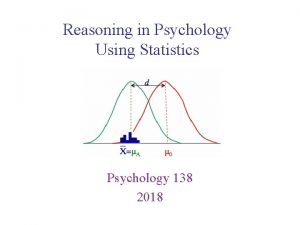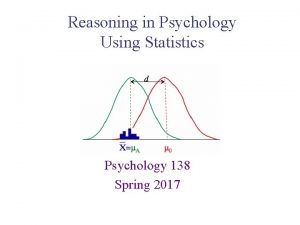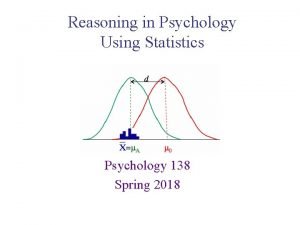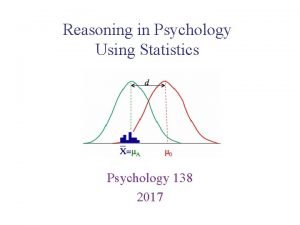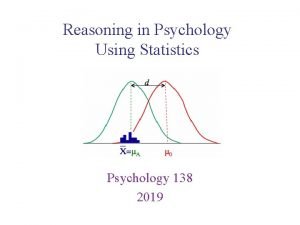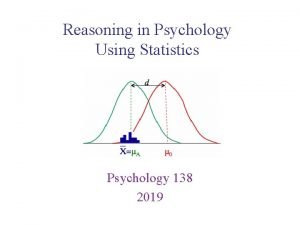Reasoning in Psychology Using Statistics Psychology 138 2015


























- Slides: 26

Reasoning in Psychology Using Statistics Psychology 138 2015

• Quiz 3 is posted, due Friday, Feb. 20 at 11: 59 pm – Covers • Tables and graphs • Measures of center • Measures of variability – You may want to have a calculator handy • Exam 2 is two weeks from today (Wed. Mar. 4 th) Annoucement Reasoning in Psychology Using Statistics

• Transformations: z-scores • Normal Distribution • Using Unit Normal Table – Combines 2 topics Outline for 2 classes Reasoning in Psychology Using Statistics Today

• Where is Bone student center? – Reference point – CVA Rotunda – Direction – North (and 10 o West) – Distance – Approx. 1625 ft. Location Reasoning in Psychology Using Statistics 1625 ft.

• Where is a score within distribution? – Reference point – Obvious choice is mean – Direction – Negative or positive sign on deviation score – Distance – Value of deviation score Locating a score Reasoning in Psychology Using Statistics μ Subtract mean from score (deviation score).

Reference point μ X 1 = 162 X 2 = 57 X 1 - 100 = +62 X 2 - 100 = -43 Locating a score Reasoning in Psychology Using Statistics Direction

Below μ Above X 1 = 162 X 2 = 57 X 1 - 100 = +62 X 2 - 100 = -43 Locating a score Reasoning in Psychology Using Statistics Direction

μ Distance X 1 = 162 X 2 = 57 X 1 - 100 = +62 X 2 - 100 = -43 Locating a score Reasoning in Psychology Using Statistics Distance

• Direction and Distance • Deviation score is valuable, • BUT measured in units of measurement of score • AND lacks information about average deviation • SO, convert raw score (X) to standard score (z). Raw score Population mean Population standard deviation Transforming a score Reasoning in Psychology Using Statistics

μ z-score: standardized location of X value within distribution If X 1 = 162, z = X 1 - 100 = +1. 24 50 If X 2 = 57, z = X 2 - 100 = -0. 86 50 • Direction. Sign of z-score (+ or -): whether score is above or below mean • Distance. Value of z-score: distance from mean in standard deviation units Transforming scores Reasoning in Psychology Using Statistics

μ = 20 σ=5 μ z-score: standardized location of X value within distribution If X 1 = 26, z = X 1 - 20 = +1. 2 5 If X 2 = 16, z = X 2 - 20 = -0. 8 5 • Direction. Sign of z-score (+ or -): whether score is above or below mean • Distance. Value of z-score: distance from mean in standard deviation units Transforming scores Reasoning in Psychology Using Statistics

• Can transform all of scores in distribution – Called a standardized distribution • Has known properties (e. g. , mean & stdev) • Used to make dissimilar distributions comparable – Comparing your height and weight – Combining GPA and GRE scores – z-distribution • One of most common standardized distributions • Can transform all observations to z-scores if know distribution mean & standard deviation Transforming distributions Reasoning in Psychology Using Statistics

• Shape: • Mean: • Standard Deviation: Properties of z-score distribution Reasoning in Psychology Using Statistics

• Shape: Same as original distribution of raw scores. Every score stays in same position relative to every other score. transformation 50 μ 150 original μZ z-score • Note: this is true for other shaped distributions too: – e. g. , skewed, mulitmodal, etc. Properties of z-score distribution Reasoning in Psychology Using Statistics

• Shape: Same as original distribution of raw scores. Every score stays in same position relative to every other score • Mean o o If X = μ, z = ? Meanz always = 0 transformation 50 Xmean = 100 μ 150 μZ = 0 =0 Properties of z-score distribution Reasoning in Psychology Using Statistics

• Shape: Same as original distribution of raw scores. Every score stays in same position relative to every other score • Mean: always = 0 • Standard Deviation: Properties of z-score distribution Reasoning in Psychology Using Statistics

• Shape: Same as original distribution of raw scores. Every score stays in same position relative to every other score • Mean: always = 0 • Standard Deviation: For z, transformation 50 X+1 std = 150 μ +1 = +1 z is in standard deviation units Properties of z-score distribution Reasoning in Psychology Using Statistics

• Shape: Same as original distribution of raw scores. Every score stays in same position relative to every other score • Mean: always = 0 • Standard Deviation: For z, transformation 50 X+1 std = 150 X-1 std = 50 μ 150 -1 μ +1 = -1 Properties of z-score distribution Reasoning in Psychology Using Statistics

• Shape: Same as original distribution of raw scores. Every score stays in same position relative to every other score • Mean: always = 0 • Standard Deviation: always = 1, so it defines units of zscore Properties of z-score distribution Reasoning in Psychology Using Statistics

• If know z-score and mean & standard deviation of original distribution, can find raw score (X) – have 3 values, solve for 1 unknown (z)( σ) = (X - μ) X = (z)( σ) + μ transformation 50 μ X = 70 150 μ +1 X = (-0. 60)( 50) + 100 z = -0. 60 = -30 +100 From z to raw score: Reasoning in Psychology Using Statistics -1

• Population parameters of SAT: μ= 500, σ= 100 Example 1 A student got 580 on the SAT. What is her z-score? Another student got 420. What is her z-score? SAT examples Reasoning in Psychology Using Statistics

• Population parameters of SAT: μ= 500, σ= 100 Example 2 Student said she got 1. 5 SD above mean on SAT. What is her raw score? X = z σ + μ = (1. 5)(100) + 500 = 150 + 500 = 650 • Standardized tests often convert scores to: μ = 500, σ = 100 (SAT, GRE) μ = 50, σ = 10 (Big 5 personality traits) SAT examples Reasoning in Psychology Using Statistics

• SAT: μ = 500, σ = 100 • ACT: μ = 21, σ = 3 Example 3 Suppose you got 630 on SAT & 26 on ACT. Which score should you report on your application? z-score of 1. 67 (ACT) is higher than z-score of 1. 3 (SAT), so report your ACT score. SAT examples Reasoning in Psychology Using Statistics

Example 4 On Aptitude test A, a student scores 58, which is. 5 SD below the mean. What would his predicted score be on other aptitude tests (B & C) that are highly correlated with the first one? Test B: μ = 20, σ = 5 XB < or > 20? How much: 1? 2. 5? 5? 10? Test C: μ = 100, σ = 20 XC < or > 100? How much: 20? 10? If XA = -. 5 SD, then z. A = -. 5 XB = z. B σ + μ= (-. 5)(5) + 20 = -2. 5 + 20 = 17. 5 XC = z. C σ + μ = (-. 5)(20) + 100 = -10 + 100 = 90 Find out later that this is true only if perfectly correlated; if less so, then XB and XC closer to mean. Example with other tests Reasoning in Psychology Using Statistics

Population Mean Standard Deviation Z-score Formula Summary Reasoning in Psychology Using Statistics Sample

• In lab – Using SPSS to convert raw scores into z-scores; copy formulas with absolute reference • Questions? Wrap up Reasoning in Psychology Using Statistics
 Inductive reasoning moves from
Inductive reasoning moves from Inductive reasoning definition
Inductive reasoning definition Example of inductive reasoning and deductive reasoning
Example of inductive reasoning and deductive reasoning Deductive vs inductive
Deductive vs inductive Inductive vs deductive geometry
Inductive vs deductive geometry Inductive reasoning patterns
Inductive reasoning patterns Inductive reasoning and deductive reasoning
Inductive reasoning and deductive reasoning Introduction to statistics what is statistics
Introduction to statistics what is statistics Using deductive reasoning to verify conjectures
Using deductive reasoning to verify conjectures Using inductive reasoning to make conjectures
Using inductive reasoning to make conjectures Using deductive reasoning to verify conjectures
Using deductive reasoning to verify conjectures Inductive reasoning examples
Inductive reasoning examples Using inductive reasoning to make conjectures
Using inductive reasoning to make conjectures Using inductive reasoning to make conjectures
Using inductive reasoning to make conjectures Using deductive reasoning to verify conjectures
Using deductive reasoning to verify conjectures Using deductive reasoning to verify conjectures
Using deductive reasoning to verify conjectures Using deductive reasoning to verify conjectures
Using deductive reasoning to verify conjectures Salmo 138 5
Salmo 138 5 Realidades 2 page 138
Realidades 2 page 138 Makin serupa yesus tuhanku
Makin serupa yesus tuhanku Hkr 118 uitm
Hkr 118 uitm Direct object pronoun for la mochila
Direct object pronoun for la mochila Adverb vs adjective examples
Adverb vs adjective examples Astm c 138
Astm c 138 Psalm 138 1-3
Psalm 138 1-3 Tiempo de orar salmo 138
Tiempo de orar salmo 138 Tec-138-702
Tec-138-702








